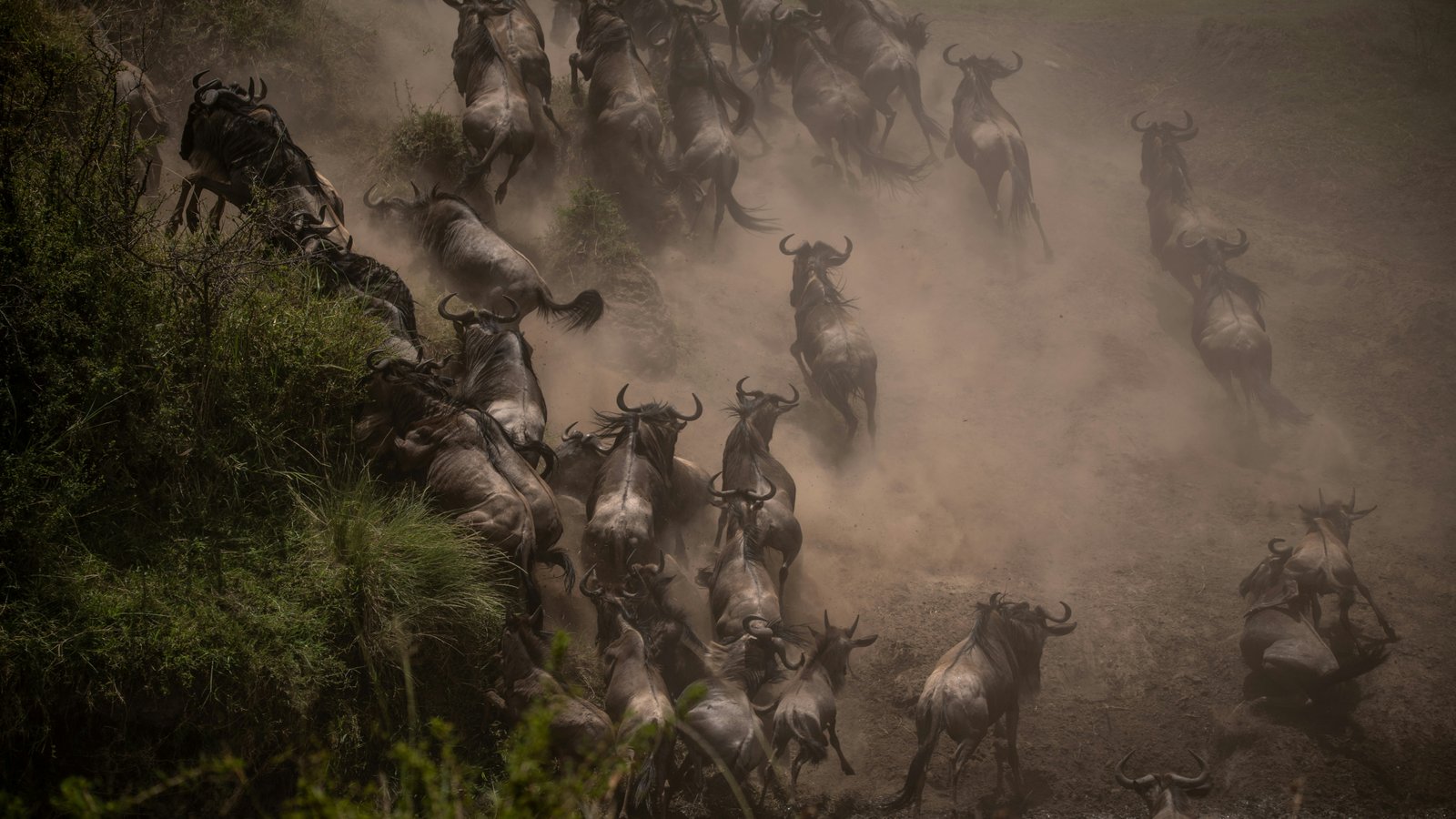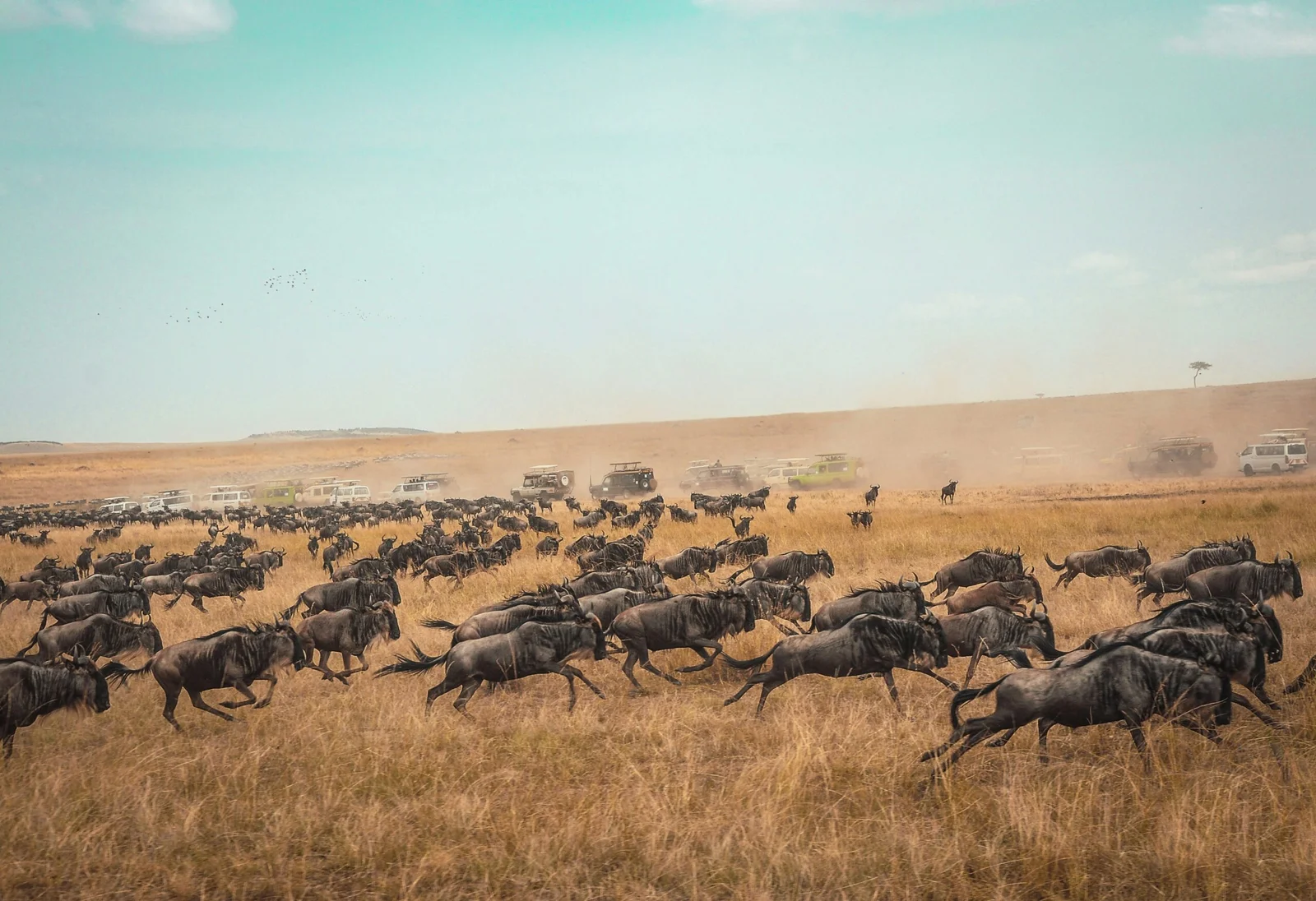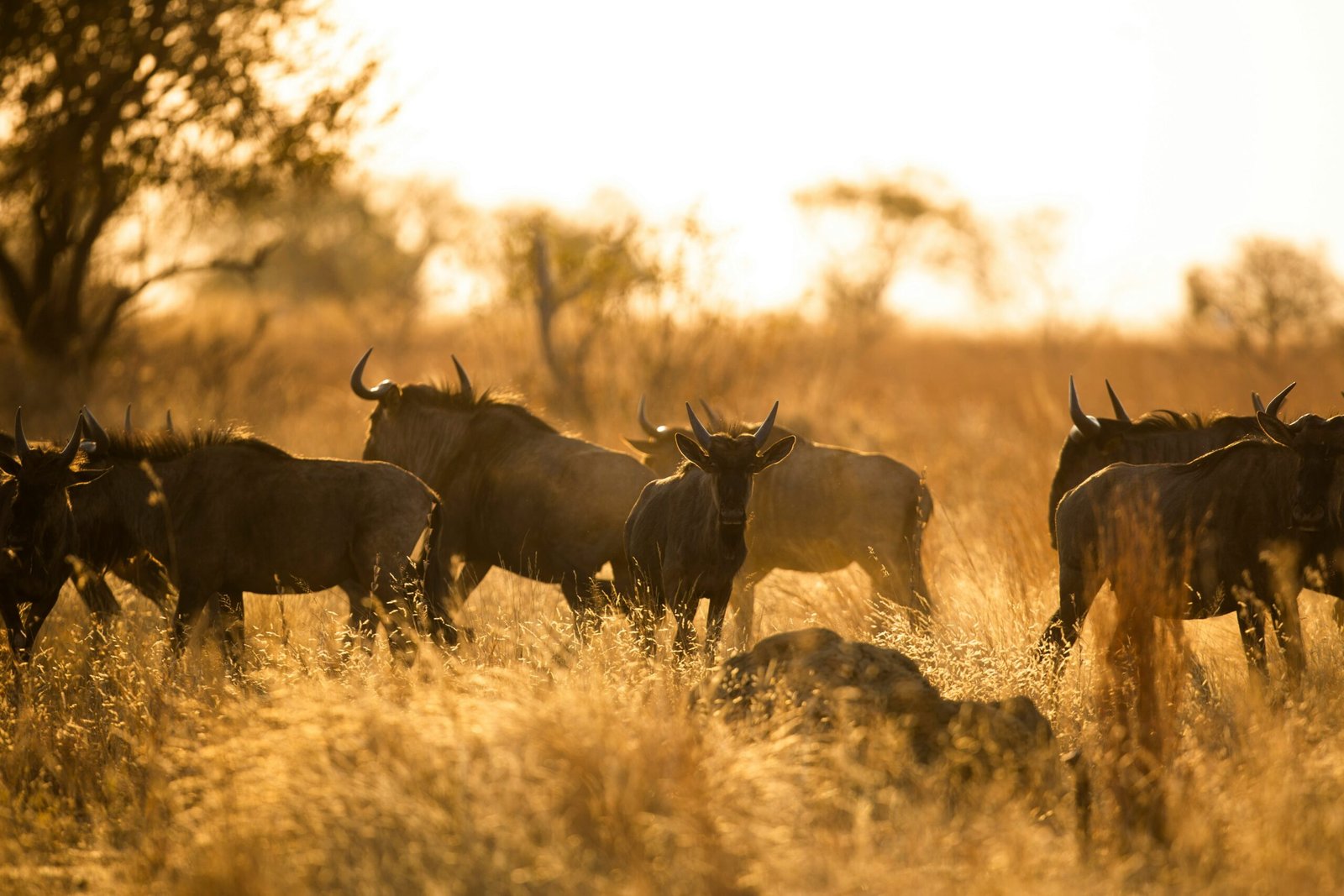Why Choose Tanzania for Your Safari: Discover
Why Choose Tanzania for Your Safari: Discover the Best Experience Home
The Great Wildebeest Migration is one of the most extraordinary wildlife spectacles on Earth. Every year, over 1.5 million wildebeest, accompanied by hundreds of thousands of zebras and gazelles, embark on a dangerous and awe-inspiring journey across the Serengeti-Mara ecosystem. This epic migration, often called "The Greatest Show on Earth," is a continuous cycle of movement, survival, and renewal, offering travelers an unforgettable safari experience. Whether you're a nature enthusiast, photographer, or first-time safari-goer, witnessing this natural wonder should be on your bucket list!
The migration is driven by rainfall patterns and the search for fresh grazing lands. The wildebeest move in a clockwise loop across the Serengeti (Tanzania) and the Maasai Mara (Kenya), covering over 1,800 miles (2,900 km) annually.
Calving Season (January – March)
Long Trek North (April – June)
River Crossings (July – September)
Return to the Serengeti (October – December)
📌 Tip: The best time to witness the Great Migration depends on what part of the journey you want to see!
| Month | Migration Phase | Best Viewing Locations |
|---|---|---|
| Jan – Mar | Calving season | Southern Serengeti, Ndutu region |
| Apr – June | Herds move north | Western Serengeti, Grumeti Reserve |
| July – Sept | River crossings | Northern Serengeti, Maasai Mara |
| Oct – Dec | Return to Serengeti | Central & Eastern Serengeti |
📌 Tip: To see the thrilling river crossings, visit the Grumeti River (June – July) or Mara River (July – September).
Not all Kilimanjaro routes are the same. The best ones for full moon climbs include:
The wildebeest migration is a battle for survival, with numerous challenges along the way:
📌 Tip: Watching the migration is thrilling, but also emotional—it’s nature at its rawest.

The Great Migration doesn’t just involve wildebeest! Many other animals play a crucial role in this ecosystem.
📌 Tip: The interaction between predators and prey is one of the most fascinating aspects of the migration.
The migration is more than just a spectacle—it shapes the entire Serengeti ecosystem.
📌 Tip: The Serengeti-Mara ecosystem is one of the last remaining intact migration corridors in the world.

Despite its natural wonder, the Great Migration faces threats, including:
📌 Tip: By choosing eco-friendly safari operators, you support conservation efforts!
📌 Tip: Book at least 6 months in advance for peak migration periods!
📌 Tip: A portion of safari fees supports conservation efforts—so your trip helps protect Tanzania’s wildlife!

The Great Wildebeest Migration is one of the most extraordinary wildlife events on Earth. From the drama of river crossings to the beauty of the Serengeti plains, it’s a once-in-a-lifetime safari experience.
Join Nyange Adventures for a customized migration safari and experience nature’s greatest journey! Contact us today to plan your unforgettable adventure.
EXCELLENTVerified Excellent and exceptional experience! My experience couldn't be better and I couldn't recommend Nyange more! They are excellent and I'm super satisfied with everything.I booked my climbing to Kilimanjaro with them and everything was perfect from the starting communication to the very last second I was with them.I'm a woman solo traveler and I felt safe every single time.All the staff is very nice, helpful and attentive. They really make the phrase "come as a client, leave as a friend" come true, I'll miss everyone! Special thanks to my guide in Kilimanjaro: Amnaay (if you wanna go with him, I assure you'll have a fun and pleasant time! He knows a lot, is very encouraging and literally held me when I couldn't walk anymore. I don't know if I could reach the summit without him and all the other guys that came with me - the cooker, waiter and porters, everyone special, very professional and has their space in my heart).They arranged everything I needed: my commuting from the city center to the farm (their farm is amaaaaazing, beautiful and the room was super comfortable and clean and with a breathtaking view of Kilimanjaro. All the delicious food they make is local - with ingredients from the farm), even in my last night Amnaay asked them if they could cook Ugali for me, and they did!The owner, Praise, is also very caring and himself always make sure that everything is ok, always having nice conversations, asking if I need something, etc.I could be here writing a review of 50 pages only speaking good things about them. Highly recommend! It was for sure the best experience in my life and thanks for them!Verified Highly Recommend Nyange Adventures - a life changing experience I highly recommend Nyange Adventures. Amina coordinated our tour and was extremely helpful, communicative, and accommodating. We did a 9-day safari and 3-days in Zanzibar all coordinated through Nyange Adventures for our honeymoon. It was the perfect amount of time if you plan to do both Central Serengeti (most popular) and Northern Serengeti (Wildebeest migration in September), which we did. I wish we had more time in Zanzibar, and we could have easily spent 5-7 days there and scuba dived. Our safari was exceptional because our guide, Joseph, was top notch. Joseph is so kind and professional. He went out of his way to make sure we had an incredible experience. Joseph knew where to go, when to wake up, and he was just as excited to see the wildlife as we were, which made it even better. Our stays were mid-tier, and we always had a shower and bathroom. Some stays were better than others, admittedly, but the food was always delicious and the hospitality of the staff was incredible. Be prepared to spend a lot of time in the car and on bumpy, wild, and remote roads... remember that is what a safari entails. Be patient and let go of control. In order to access once-in-a-lifetime nature, you have to rough it a bit. We enjoyed learning more about the history of Tanzania (Tan-gan-ika) and Swahili culture. Do not skip the tribe immersions (we met the Hadzabe, Datoga, and Masai tribes). Pay your white people tax and spread USD tips around. Bring a lot of cash with you as we had trouble accessing ATMs. I wish we brought more cash, so we didn't have to waste time figuring out how to pay once we arrived. Amina warned me, but I didn't understand and if I went again, I would bring even more USD. Hadiya was our guide in Zanzibar. We did a walking tour with her. She was very informative, kind, and helpful. Skip the spice tour if you can... it is a big tourist trap. After a safari, you might want some time to decompress at these incredible beaches. Be prepared that the tides are strong and occur in the middle of the day. Amina booked a perfect hotel for us - the Sunshine Marine Lodge. In Zanzibar, it really matters where you stay! My only regret is not scuba diving. We ended our days on safari with a campfire and a dancing ceremony. I would highly recommend learning Swahili words and using Swahili language with locals. There is a lot to learn from the people who live in Tanzania - every person we met had a unique story and shared more about their way of life. Be patient. Embrace their culture and learn something. I really didn't want to leave and I can't wait to go back. I think about this experience every day.Verified Best team ever! I can honestly say that this was one of the best experiences I have ever had traveling. It was made special because of the amazing people who supported our trek up Kily- from our awesome guides, Amnaay and Musa, to Oscar, our chef, who prepared delicious meals to Steve, our waiter,who ensured all of our needs were met to Mohammed who ensured our tents and sleeping quarters were up to snuff and ever porter who supported our hike. Everyday I looked forward to seeing our team on the mountain, they always had smiles on their faces and were cheering us along the way. We became family as we shared time together and I learned to trust my team. Nyange Adventures is top notch and I highly recommend Nyange for your trek up Kily!Verified Trip of a lifetime in the Ngorongoro crater with Rashidi Spent three days with Rashidi at the Ngorongoro crater and had the time of a life. Rashidi is an excellent guide. Not only can he spot the mammals, sometimes from kilometers away. But he can spot birds too. He can recognize the calls and finds them when they are hidden in thick bush. His English is great and he is knowledgeable about the land and people as well. We saw giraffes, lions, elephants, rhinos, serval cats, water buffalo, wildebeest, zebras, hippos, plus over 30 species of birds! Can’t recommend this company and Rashidi enough.Verified Overnight guide tour to Ngorongoro Crater We had a very last minute opportunity with 3 extra days on a Tanzania mission trip and Nyange did a beautiful job arranging two nights at Ngorongoro Crater with a full day of birding and wildlife in the Crater. They welcomed us at Kilamanjaro International Airport and drove us to Dodoma and the end of the three days. Arrangements were great. Praise was very prompt with queries and helping get myself my wife and three friends all set up. Rashid was our guide and driver, took excellent care of us and demonstrated great guiding skills identifying birds large and small along with really good wildlife finds including 3 rhinos and a Serval Cat. I would highly recommend this group to anyone.Verified Roof of Africa From the Safari to Kilimanjaro to ZanzibarEverything was arranged and sorted by these guysWhat a truly spellbinding experience into the heart of TanzaniaOne for the booksExtremely reliable company and staffVerified Terriffic Tanzania We had the most amazing, interesting and memorable adventure in Tanzania. We had a 12-days adventure meeting tripes, local people in the villages, safari tours, waterfalls and farms. We had Francis Boniphase as our guide during the entire trip. He is very friendly and is curious to learn and give his knowledge to us. We also met the owner of the Nyange (Praise Nyange) who gave us some awesome experiences on his farm.Verified Made it with Nyange! My son and I just reached the summit on the 8 day Lemosho climb with the fabulous crew of Nyange. Special shout out to our guide Amnaay and the assistant guide Henry, without whom we would not have succeeded. On summit day, they carried our day packs, kept us at a steady pace (believe me, that is a good thing), when at several points I was ready to give up. We were one of the first ones to get there just in time to watch to most glorious sunrise. Then, they pretty much held on to us on the rapid and harrowing decent. I found Nyange hightly recommened in Stedman's book. It is a small local outfit that supports KPAP. The owner, who was once a porter, even came to say hi to us during our last day in Moshi. There are lots of operators, a couple of them had huge groups of trekkers, and I am sure they all do a fine job, but I chose to go with a local company and I am so glad I did. And, don't let anyone tell you Kilimanjaro is easy. It was very, very hard!Verified by TrustindexTrustindex verified badge is the Universal Symbol of Trust. Only the greatest companies can get the verified badge who has a review score above 4.5, based on customer reviews over the past 12 months. Read more
Why Choose Tanzania for Your Safari: Discover the Best Experience Home
Ultimate Guide to Safari Accommodations in Tanzania Home Table of Contents
Explore 5 Types of Tanzania Safari Accommodations Table of Contents Introduction
Ultimate Guide to Game Drives in Tanzania: Experience the Wild Table
© 2025 Nyange Adventures All Rights Reserved.
Use this feature to chat with our agent.